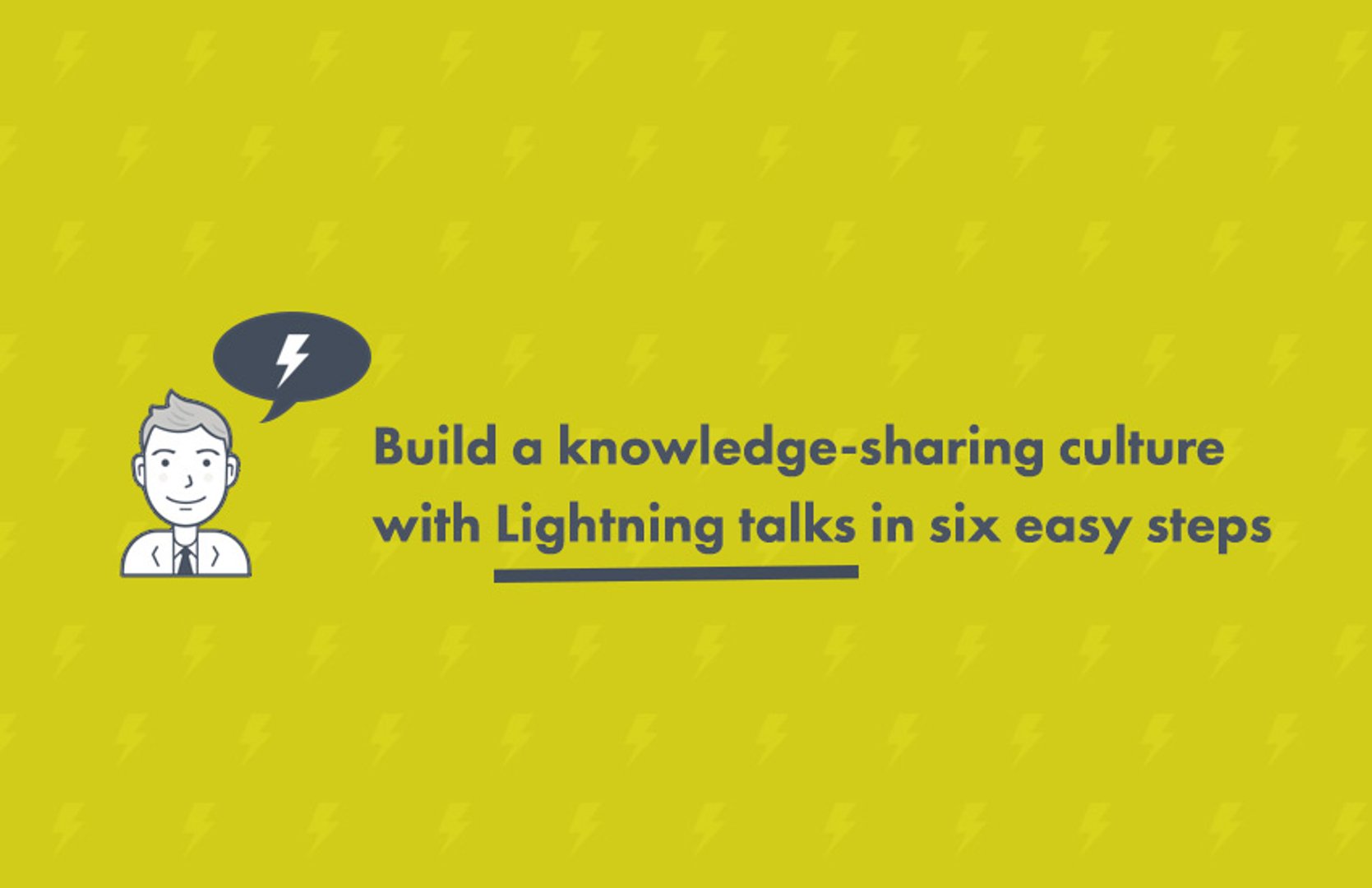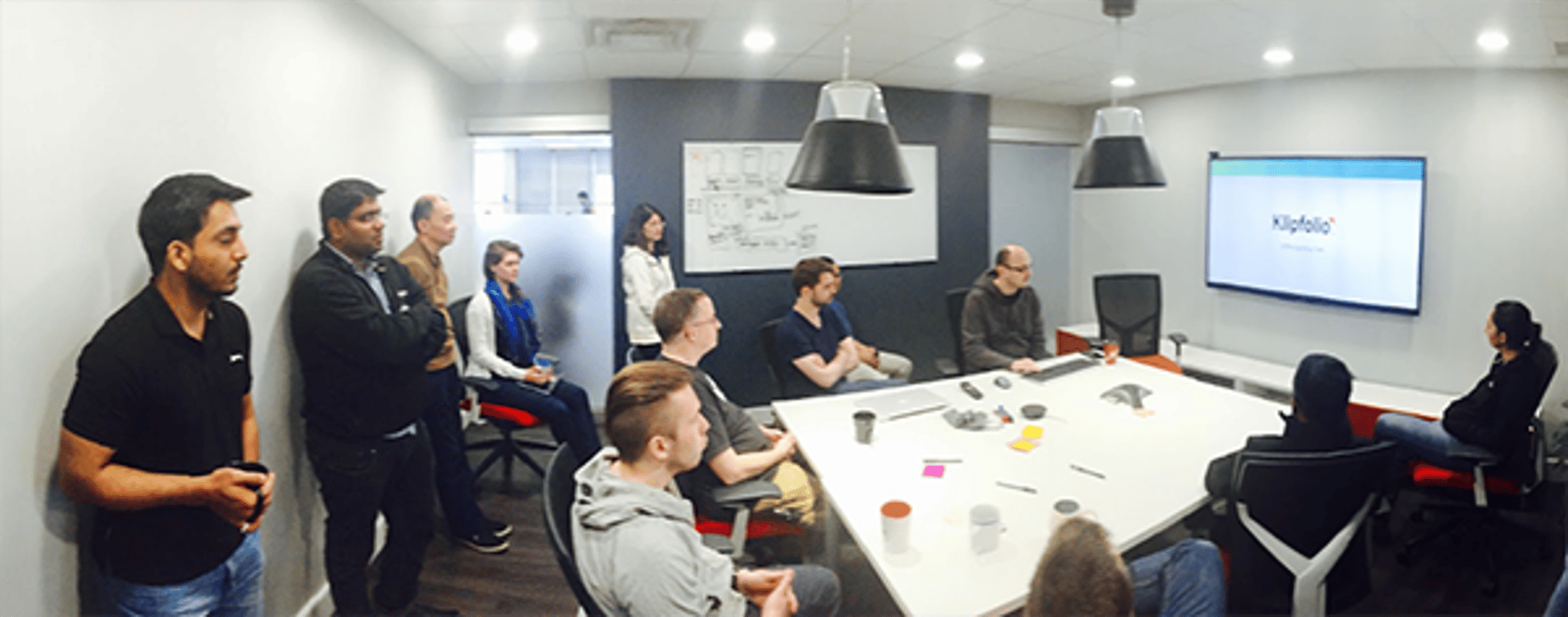Build a knowledge-sharing culture with Lightning talks in six easy steps

Published 2023-02-01
Summary - When a team forms and grows, it’s composed of members from a variety of educational and work backgrounds. And each person comes to the table with something different to offer. We’ve been using Lightning talks at Klipfolio to share knowledge with our co-workers. Here are the 6 steps to creating your own lighting talks.
Build a knowledge-sharing culture with Lightning talks in six easy steps
It’s Friday and we are all looking forward to another Lightning talk. Mark, our CTO, and one of the new team members, Chris, are each giving a talk this week. Mark’s talk is on our data layer and some tricky parallelism and concurrency problems he’s had to solve for our platform to scale in the cloud. While Chris’s talk is on how to use the new log builder library that he’s put together to make everyone’s life easier and our logs consistent across the platform. I already know I am going to learn a lot in this one but that’s not unusual as I always learn something new in our Lightning talks.
It’s one hour later… and although we have a team lunch to go to, everyone is still engaged, asking questions and brainstorming. OMG, I learned even more than I thought I would… I am so excited that I am getting goosebumps. I mention to Mark: “this was a great talk, you should make this public and give a variation of the talk at the university to software engineering and computer science students…” and then we head out for the team lunch.
This is very typical of how things unfold every other Friday in Klipfolio’s R&D department. If you want to have your own Lightning talks and promote an engaging knowledge sharing culture, read on.

Why information sharing is important?
When a team forms and grows, it’s composed of members from a variety of educational and work backgrounds. And each person comes to the table with something different to offer. Teams, as form and grow and mature, face many challenges including:
- Sharing knowledge and information
- Finding and using similar terminology to avoid communication breakdown
- Solving the same problems over and over again (reinventing the wheel) not knowing who is the expert or who they can ask for help
- Not having a formal channel to communicate their ideas
Knowledge sharing in organizations, it’s problems and challenges, has been studied in depth, as discussed in this article in the Journal of Basic and Applied Sciences. The benefits of knowledge sharing as summed up in this paper based on numerous research studies are:
- Fostering innovation and creativity by keeping the information flow and therefore achieving competitive advantage
- Improved productivity and performance as well as advancement towards the mission
- Keeping the knowledge in the organization if/when the people leave
- Organization’s self-awareness of the knowledge residing in the organization
- Eliminating redundant and unnecessary work.
I would also like to add the following point:
- Learning and mastery of various topics go a long way to keeping knowledge workers engaged and happy (as I discussed in another post on organizing hackathons).
It’s fair to ask if all the benefits are geared toward the organizations, what do I get out of this as an individual?
As the person who attends:
- You learn things
- You get to know people who know things you don’t know
- By hearing new ideas, you remain creative
As the person who presents:
- You will be known as an SME (Subject matter experts)
- You build credibility to become a technical leader
- You practice public speaking
- You get to bring your ideas to the table and influence the team
The problems and benefits as discussed above are especially important in fast moving environments with knowledge workers. Having a semi-formal channel for communicating what’s happening in the organization and allowing team members to share their thoughts and know-how, in addition to the usual product demos, can be very helpful for everyone. We’ve been using Lightning talks in this way and they’ve been a great for us to helping us to keep information flowing in the team.
What’s a Lightning talk?
A Lightning talk is a presentation that takes about 5 to 15 minutes with the goal of sharing insightful and clear knowledge or persuading the audience to take an action. Organizers usually combine a number of talks into 1 or 2 hour sessions on related topics, which are sometimes called a data blitz. The term was first used by Mark Jason Dominus back in 2000. The practice was used prior to that in 1977 at a Python Conference.
The other famous term for technology presentations is Tech Talk. These are usually longer taking somewhere between 45 and 90 minutes. While Tech talks are also great, they require more of a time investment from the presenters and therefore, are harder to organize and keep going especially in smaller organizations where there are fewer resources with time to commit to that kind of preparation.
Our Lightning talks journey started in early 2015 and the dev team has been holding the sessions consistently every two weeks. This has resulted in lots of great short talks and shared reference slide decks on many related topics and relevant challenges. We’ve found lighting talks to be a great method for sharing knowledge within the team in an environment where people’s main job is not presenting content and information sharing is more of a means to an end. In addition to knowledge sharing, this is a good team building activity and public presentation practice for the team members. I’m passing on the following tips based on what we’ve learned during the process. It is my hope that this will help others take advantage of our experience. following tips are what I’d like to pass on as what we’ve learned during the process to help others take advantage of our experience.
Six tips for making Lightning talks successful
1 - Give a Lightning talk on Lightning talks:
Obviously, if the concept is new for the team, introduce it by putting a short talk together as the first example. Try to use this talk to also establish some ground rules such as:
- Template for the talks: a simple slide deck will do...
- How long they should be? 5 - 15 minutes
- Expectations such as level of preparation: not much required
- Why are talks important? See above sections
- How do the talks help the teams? Ditto
- How do the talks help the individuals? Ditto
2 - Have a simple registration page
Have a central document in place, list the potential topics and the candidates for those topics to get the team excited. Make the process for registration like everything else in this process lightweight and simple. In our case, people just write their name, the topic, and the presentation date in a table and that’s it. Even if they don’t register and just show up at the session ready to present, they can always go at the end when everyone else is finished.
3 - Make it easy and lower the bar
Use every opportunity you have to emphasize that these are not formal presentations and do not require much preparation time. In addition, save the team members time by having a template and tooling for the talks, in place. Make it clear though that they don’t have to use the template if they just want to present the content they have ready to go. Team members can present what they’ve been up to during the weeks leading to the talk, if they feel the content could be useful for the team. For instance, someone can open up their code editor and show the code for how they solved a recent problem that the team was facing or show the best practices for using the new log builder…
While the Lightning talks are supposed to be 5 - 15 minutes, don’t limit yourself and the team to that timebox. There are two reasons why allowing longer talks is a good idea: 1) Some more in-depth topics that are worth sharing won’t fit in 15 minutes. 2) Some people may have a hard time communicating their message in a 5 to 15 slot. While this is a good opportunity for them to practice that skill and they should, neither they nor their team members who are eager to learn, should be penalized. Remember the goal is information and knowledge sharing, not staying true to the definition of Lightning talks. Call them Tech Talks if you are a perfectionist :) but get it done and make it super easy for people to get it done.
4 - Lead by example and find champions
First of all, be the champion in the beginning and lead by example, by giving a 5-10 minute presentation on topics that you think would be valuable for the team. This is very important to keep the blood flowing in the first few weeks and months until the Lightning talks become part of the team’s DNA.
Obviously, you cannot do it all by yourself so find other champions who are eager to share knowledge and help them give more presentations by giving them ideas in conversations and asking for their help to fill in the gaps. You’d be surprised how much people are willing to share and help with this kind of team event.
5 - Keep it going and make Lightning talks addictive
Remind people a few days before (ideally 1 week) the talks that they are coming up and ask them to sign up. If nobody jumps on the bandwagon, start reaching out to people and ask for their help. Target at least 1 or 2 talks per session. Do what you can to make the talks a regular part of your team’s activities. For instance, if you don’t have any internal team presenters, try to find an external speaker or find a few relevant short talk on youtube or a TED Talk. In other words, do what it takes to keep the idea of the Lightning talks alive. Knowledge workers quickly get addicted to learning. Trust me. After a few months, you don’t need to do push it anymore, it just happens organically.
6 - Pass the torch
When the Lightning talks are part of the team’s culture and they happen without much effort, it’s time for you to step down. You may ask why should I since I just made something great happen? Why would I step down and pass on the torch? Well, for one thing, this will free up your time to come up with other new initiatives. Also, given that you think you created something great, you may have blind spots and not see what can be improved. New people bring new perspectives and inevitably make things different, keep it interesting, and improve them along the way. This also gives other people in the team the opportunity to build up their leadership and organizational skills.
Wrap up
Information sharing is important in any workplace but it is a must have in workplaces with knowledge workers. Knowledge workers produce new insight and learn new technologies as they work on new projects. Invariably, there is value in sharing this knowledge among team members and having a platform in place for this is crucial. We’ve used Lightning talks at Klipfolio to build this platform and we’ve made it successful. Feel free to use our tips and drop us a comment. While we like to learn from each other, we also like to learn from others’ experiences, as well.
Related Articles

Klipfolio Partner How-To #2: Company Properties can simplify client set-up
By Stef Reid — November 26th, 2025
Klipfolio Partner How-To #1: Duplicating dashboards across client accounts
By Stef Reid — November 26th, 2025
12 Important Sales Enablement Metrics You Shouldn't Miss
By Grace Lau — September 19th, 2025

